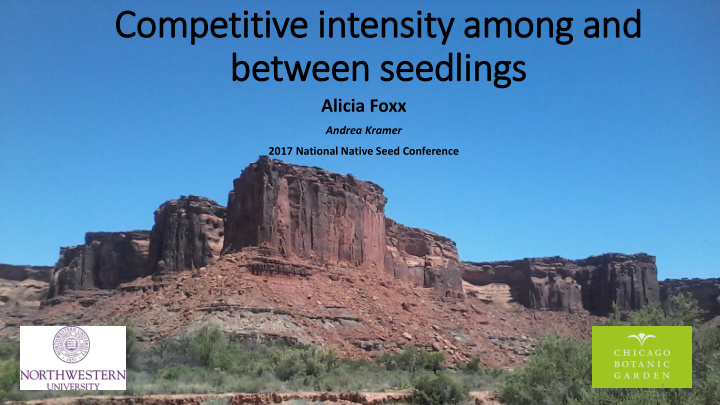



Competitive in intensity among and between seedlings Alicia Foxx Andrea Kramer 2017 National Native Seed Conference 1
Plant interactions • Objective 2.3 of the National Native seed strategy that calls for research on plant establishment, species interactions, and ecological interactions • Explore interactions among native and between native and non-native plants 2
Restoration in the arid west • Restoration efforts are plagued by substantial seedling failure due to environmental factors and competition from aggressive species • Dry, disturbed, fire prone • Low productivity, high competition • Hinders creating diverse plant assemblages • Diversity benefits, ecosystem services, & wildlife support 3
Plant seedlings • Vulnerable life stage to abiotic and biotic stressors (Moles & Westoby 2003) Soil resources Pathogens Light availability Herbivores Temperature Adult & seedling competitors Water avail • Competition imposed on seedlings is more detrimental than among adults (Weigelt et al. 2002, Spasojevic et al. 2014) • Population dynamics may govern whether competition between individuals of the same species differ from those of different species 4
Negative density dependence • Individuals of the same species share more similar resource needs [etc.] than individuals of differing species • Expected to cause competition among individuals of the same species to be more intense than between individuals of different species • This sounds bad, but… 5
Stabilizing niche mechanisms • Promotes diversity (Chesson 2000, 2008) • Reduce overabundance • Help buffer small populations from extinction • intense within species competition is alleviated due to low numbers 6
Less intense More intense 7
Less intense Less intense 8
Negative density dependence • Negative density dependences • More facilitation between individuals of the same species • Contributes to overabundance and dominances • Detrimental to diversity 9
More intense less intense 10
Restoration & plant interactions • High diversity in restoration is often a goal • Plant-plant interactions can play a major role in the establishment of species & maintaining diversity • We need to know more about the within- and between species interaction dynamics to inform seed mix design 11
Das Study (German for “the Study”): • Objective • Determine if the interaction strength differs among individuals of the same species compared to competition between species 12
Das Study • Species used: • Considered as high priority species for restoration in the Colorado Plateau • Species • Helianthus annuus (common sunflower) $ • Linum lewisii (native blue flax) $ • Linum perenne (blue) $ • Pascopyrum smithii (western wheatgrass) w • Accessions purchased or wild collected • Stored in the Dixon National Tallgrass Prairie Seed Bank 13
Das Study • Sand in conetainers • Growth chamber • Seven weeks • Three treatment groups Control Monoculture Biculture 14
Interaction dynamics • Data • above- and belowground mass 𝑆𝑝𝑝𝑢 𝑛𝑏𝑡𝑡 • root mass fraction (RMF) 𝑈𝑝𝑢𝑏𝑚 𝑛𝑏𝑡𝑡 𝑆𝑁𝐺 𝑝𝑔 𝑓𝑦𝑞𝑓𝑠𝑗𝑛𝑓𝑜𝑢𝑏𝑚 𝑠𝑝𝑣𝑞 ) • Effect size calculation ln( 𝑆𝑁𝐺 𝑝𝑔 𝑑𝑝𝑜𝑢𝑠𝑝𝑚 𝑠𝑝𝑣𝑞 15
Roots & Interactions • Roots • Important for resource acquisition • Soil biota associations • Non-resource based communications. • Important interface for interactions ( e.g. Acciaressi & Guiamet 2010, Foxx & Kramer in prep) • Most intense interactions occur between roots ( Kiӕr et al. 2013) 16
Interaction dynamics Effect size comparison p = 0.037 17
Interaction dynamics • Four of seven combinations competed more intensely with individuals of the same species than of other species • Helianthus annuus & Linum lewisii • Two species competed more intensely with individuals of different species • Pascopyrum smithii & Linum perenne • P. smithii can become dominant where introduced and L. perenne can also become abundant • L. perenne is non-native, used in restoration, and can become abundant • Varies by population? • These dynamics may limit diversity via competitive exclusion of different species • Seed mix design consideration 18
Future Work • Elucidate how intraspecific variation and plastic responses can change the competitive relationships between individuals of the same and different species using native and invasive species • Mechanistic understanding of how dominant and invasive species negatively impact plant establishment and coexistence 19
Acknowledgements Andrea Kramer, PhD Amy Iler , PhD Thank you! Stuart Wagenius , PhD Florian Fort , PhD Kramer- Havens Lab group Community Ecology Lab group Ali liciaFoxx2014@u.northwestern.edu PBC PhD Fellowship Colorado Plateau Native Plant Program Bureau of Land Management 20
Recommend
More recommend